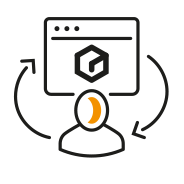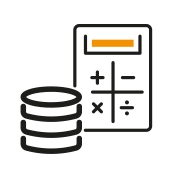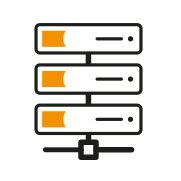If it can link these complex structures, advanced analytics isn’t just a crucial component in any company’s digitalization strategy, but also a lucrative investment.
How Buyers Can Use Advanced Analytics
Digitalization and new technologies have changed our private and professional lives and actions significantly over the last five years. Companies are not only noticing these trends in the changing patterns in consumer demand, but also through the entire supply chain.
Many companies are currently in a race for customers, on the one hand, and for raw materials on the other, and they are investing more and more money in digital transformation. However, many digitalization projects fail because of a lack of specialist understanding and the right focus. There has long been a wide range of tools available that can make staff’s work more efficient and effective. In procurement, too, companies can and should make use of digital tools and methods such as advanced analytics, e-sourcing, KI & ML.
Sometimes the minds behind the greatest science fiction stories had a good idea of what the future might look like; for example, the people who designed the bridge of the legendary Starship Enterprise:
Large screens on the walls and in front of them buttons for controlling the entire starship. Similar control rooms might very soon be reality in supply chain managers’ and buyers’ offices – definitely before the year 2200, and not just for space travel, but in companies worldwide.
The rise of advanced analytics in every area has created new opportunities for data analysis and visualization. Soon, anyone keen to optimize business processes won’t be sitting in front of mountains of paper any longer, but in front of large monitors that show where potential can still be exploited, in real time.
Competence profiles

The Organization’s Digital Maturity
The essential first step is to define your expectations of digitalization, because these can often be wide-ranging. Machine learning, artificial intelligence and blockchain will certainly be of help in the future, but these concepts are often still very abstract and it’s important to put them in concrete terms concerning a company’s purpose and requirements.
First of all, those responsible for digitalization need to demystify the process. Usually, it’s not about turning all of the company’s processes upside down in a disruptive way, but just about adapting some processes to make them more effective. Instead of going straight for a blockchain solution, aspects such as e-sourcing, process performance or advanced analytics can be a sensible first step. Managers who formulate concrete and realistic expectations can take the pressure off themselves and allay employees’ fears.
Digitalization does not follow a “one size fits all” principle; every company is structured differently. A tailor-made roadmap for your digitalization process should take this into account. Your specific company structure and existing decision-making processes should also be considered.
As soon as you’ve defined the roadmap, the next task is making the relevant processes transparent and digitizing them with the aid of tools. The main foundation is an agile and cross-departmental way of working. Concepts such as SCRUM are helpful, but it’s important to get training or talk to experts first.
It’s only when you’ve reached organizational readiness that it makes sense to take concrete measures; projects involving advanced analytics, in particular, require a fundamental paradigm shift in procurement. It’s not just about creating descriptive, retrospective data analyses, but ensuring that future events and scenarios can be modelled, for example, predictive analytics, digital twins or simulations.
Advanced Analytics in Procurement
Advanced analytics promises major efficiency gains, especially in procurement. There are many potential applications. So much is possible, from pure visualization using customized dashboards to the analysis of trends and simulation of future scenarios.
First, however, comes the data extraction. It’s not about going deep into databases and looking for hidden data; instead, everyone involved should help to create transparency – from identifying relevant data sources and their storage location to the possibility of linking them.
You can then define the analysis you want more specifically, based on this data and the goals you want to achieve. Depending on your goals, this could be, for example, a seasonal comparison, logistics costs per kilometer, and external indices such as raw material prices or currency fluctuations that have an indirect effect on your business. The collected data then needs to go through what we call a “sanity check”: incorrect data that could distort the analysis results need to be filtered out.
This can often be commonplace, especially when data is updated manually. It can lead to many errors, for example with prices if an extra zero appears in your document. The actual analysis begins with the clean data set. For the analysis it is important to set clear goals: analysis for the sake of analysis won’t bring about promising results.
Our example of a large transmission manufacturer shows how much potential lies hidden in advanced analytics: for many years, the company had a very fragmented approach to the use of data analysis in their procurement. Each department used its own analysis tools and different databases, which meant a consolidated view and exploitation of the company’s existing analysis potential was impossible.
Using a few small but effective measures, we were able to build ten procurement-related dashboards from the existing data, all highlighting different aspects. For example, these dashboards visualize exchange rate fluctuations and help identify possible sales advantages for suppliers so that these findings can be used in negotiations. Should-costing analyses are also part of the company’s new toolbox: by using in-house and external data, it’s now possible to precisely evaluate the price a supplier is charging and determine what a reasonable price for this product would be.
- 1. Purchase Price vs. Quantity Developement
- 2. Supplier Competition on Material Number
- 3. Best Price Potential
- 4. ...
The database required for this very comprehensive toolbox was by no means complex: the company just needed order data for the last three years, with some extra information from the accounting department. It also includes data from publicly available sources, such as exchange rates. Employees can easily update the toolbox with new datasets so that the analyses created are always up to date. They can also adjust how the dashboards look without any in-depth IT expertise. Thanks to the toolbox, the company has managed to use existing company data combined with external sources. This way, it could exploit the full potential of procurement data and gain insights that now make decision-making easier.

Below, we offer some specific, beneficial use cases that companies can use as a guide:
Companies can use a spend cube to analyze their entire spending structure and identify opportunities. As well as orders and invoices, companies can also feed in external data sources such as material prices. The analysis tools behind the scenes work much faster than an employee could: millions of files can be processed quite easily.
The overview can also be helpful when it comes to ordering times, for example: are certain materials cheaper in spring than in the fall? Is it perhaps worth buying earlier and storing for longer? Which suppliers charge higher prices? Can these differences be explained by material costs? By using spend cubes, procurement managers not only control their organization’s purchasing behavior more efficiently, but also have sound data as the basis for supplier negotiations.
Companies can add another dimension to their expenditure data by optimizing their inventory with inventory lists and sales figures. Whether it’s in the warehouse, pre-production or the end user’s business, some parts and products stay on the shelf longer than others. Procurement can identify which items are in particular demand and adjust accordingly; why continue placing orders at the same rate for “deadstock”? And if demand for certain products should change, decisions can be revised thanks to the real-time nature of the data being processed.
Thanks to advanced analytics, companies are also approaching warehousing from a different perspective. Traditional spare parts management can be made much more efficient by using new tools. Unnecessary warehousing results in high costs. With the help of analysis tools, it’s easy to identify which parts have been lying around forever, which parts you have too many of and whether parts are stored in different locations at the same time, for no reason. In practical terms, some stock can be reduced by up to 50%.
As well as transparency of the status quo, advanced analytics also offers the option of preventing potential problems that could arise in the future. The Covid pandemic and delays in the supply chain have made it clear how fragile supply chain security is for some companies. Advanced analytics simulates extreme situations like these and shows what effects they can have on your network. For example: what alternatives are there? How would cash requirements change? How long would the delay be? You can play out all these scenarios. If the results show that things could be precarious, buyers can use these simulations to prepare and develop emergency plans.
For all these use cases, it is important for companies not to just install the tools and leave it at that; they will need to be updated regularly in order to be more effective and productive. Managers will need to keep an eye on the increasing possibilities, but at the same time, there’s no need to be overenthusiastic and seize every opportunity to input further data: more doesn’t always mean better. The data must be relevant for your company’s goals, and contribute to your procurement targets. Once employees have familiarized themselves with the new tools, the goals, which may have been moderate at first, can become a little more ambitious.
Advanced Analytics offers a wide range of possibilities

- Retail
- Industrial Goods
- Packaging
- Automotive
- Pharmaceuticals

- Opportunity Analysis
- Implementation Phase
- Tender Preparation
- Negotiation Support

- Direct Spend
- Indirect Spend

- Utilities
- Cleaning
- Packaging
- Maintenance
- Logistics
- IT
- MRO
- Food & beverage
- Fashion

- Invoices
- Purchase Orders
- Salas Data
- Inventories
- Shipments
- Service Tickets
- Project Mgmt. Data
- Transportation Costs
- Production Volumes
- Consumption Volumes

- Spend cube & analysis
- Service level optimization
- Payment term optimization
- Maverick buying
- Role analysis
- Product portfolio analysis
- Margin analysis
- Should cost analysis
- Project tracking
Experts on DIGITAL TRANSFORMATION


Don’t Shut Yourself Away in an Ivory Tower

Oleksandr Vodotyka, MBA, has been a Head of Procurement and Supply at Coca-Cola Hellenic Bottling Company, responsible for Austria and Group Service Centers since 2016. Apart from functional operations and service agenda for his Business Units, he has been actively supporting the digital transformation of procurement as well. Some initiatives developed and piloted by his teams for process optimization and automation are now rolled-out at many other countries of the company. In our interview, he explains how far the business has already come, and why standardized processes supported by technologies are so important.
Mr. Vodotyka, you’ve been a driving force behind the digital transformation of Coca-Cola Hellenic’s procurement processes. How did this come about?
Our CPO and the leadership team, who brought me to the company, gave the go-ahead for restructuring procurement in 2015. Companywide, we’d set ourselves the goal of optimizing the costs, working more closely with our stakeholders, and making our supply chain agile and secure. We wanted to establish consistent standards. It was clear to us that we could only achieve these strategic ambitions in conjunction with optimized and digitalized procurement.
Your functional transformation has started as far back as six years ago; how far have you already come with the program?
Every transformation has a concrete starting point, but it never really ends. Our program had three phases. The first phase was all about achieving transparency for all our spend areas. We also made the strategic decision that procurement would take responsibility for every Euro that leaves the company. Before that, traditionally, different departments were responsible for negotiating and reviewing agreements with suppliers as part of their regular operations. It was also important to define the specific requirements, to find new ways of working together, and to use them to achieve a new service level within the organization.
What did the second and third phases focus on?
The second phase was probably the most challenging one. We had to completely redefine our operating model in procurement; it was all about more streamlined processes, a customized organizational structure and, of course, implementing new technologies. In some cases, we first had to utilize better those procurement tools, which were already in place but were not used to the full potential for our transformation (like e-sourcing and e-auction portal). In the third phase, that’s where we’re now, our focus is on accelerating the function for the business even further. We want to continue to automate our processes end-to-end. An important milestone of this ambition is our decision to roll out the corporate source-to-pay integrated suit for upstream and downstream procurement across all countries during the upcoming years. We also redefine the ways how we approach and automate the tale spend at the company, where we provide integrated solutions to our internal customers for easier order management through internal and external catalogs and marketplaces. This leads to new and exciting experiences for internal customers and provide procurement with more space for strategic initiatives and continuous improvements with our suppliers.
The coronavirus crisis has put many companies to the test. How robust has Coca-Cola Hellenic’s procurement proved to be, in the midst of its transformation?
The pandemic appeared to be a crash test for our improvement journey. In many areas, we could see that we were already in good shape, but in some, there was room for improvement. We were able to maintain production in Austria throughout the entire crisis, for example, thanks to our earlier implemented contingency and business continuity measures together with the functional partners. The COVID-19 situation also suggested that in some areas we had to make decisions faster. For example, the lockdown back in April last year helped us move to e-signature internally and with external partners as one of the critical means to continue our operations.
What’s been the biggest challenge so far in the transformation?
I’ve learned that you can’t just shut yourself away in your ivory tower to draw up a plan on your own. You might have developed the best strategy and have good analysis at hand, but if you don’t coordinate with other departments, you’ll never achieve the desired excellence.
From the start, we had to convince all our stakeholders that we needed to change our ways of working and that a professionally organized procurement function could become a source of greater longer-term value. We were organizing multiple cross-disciplinary workshops together for all areas of the company spend (both direct and indirect spend). We wanted to bring together all our talents to look for the best common solutions around costs, services, and the speed of execution. It was crucial to support our departments’ functional expertise with the structured data analysis and modelling to help us discuss and agree on business cases for the benefiting departments. We followed a detailed project plan, with shared responsibilities and defined timelines. For more complex initiatives, we also allowed us to pilot them on a smaller scale before expanding to full functionality and scope.
What role did your procurement team have?
Our procurement team probably played one of the most crucial roles. Especially at the beginning, we positioned ourselves as a piloting laboratory, where we tried new approaches, best practices, methods, and tools. That was made possible by the large number of committed and enthusiastic colleagues we had who wanted to join and drive the pilot projects. It was also important to work closely with everyone during implementation and to build on their skills and awareness. They’re now even prouder that procurement is completely tailored to our company’s needs. They now feel they’re really driving value creation and are tracking it through the available tools, and they’ve also contributed to building new organizational capabilities and improving our engagement with internal customers.
You have invested a lot of energy in the transformation over the last few years. Was it worth it?
Yes, without a doubt. We are now completely clear about the strategic, tactical, and operational roles that procurement plays for the company. We’ve managed to standardize our processes across departments, and now, for example, in every business unit, we use the same procedure to place and manage orders. New ways of working and source-to- pay processes supported by modern technologies provide greater opportunities for our international talent development across multiple locations. For example, our new procurement support lead in Austria, who’s responsible for the effective system processes, compliance, and analytics, has started her career at our procurement service center in Bulgaria. I am hopeful we will witness even more examples like this in the future as a part of our functional excellence journey!

Organizations have a data complexity problem

Peter Jeitschko, Solutions Sales Specialist for Artificial Intelligence at Microsoft Austria, talks in an interview about trends, collaboration between data teams and business departments – and what all this has to do with smoking at petrol stations.
Mr. Jeitschko, big data has been a trend for years. Is it now more than just a buzzword?
It is certainly more than just a buzzword. However, “big” implies that we are talking about large volumes of data. But most companies don’t have a volume problem, they have a data complexity problem. For this reason, the term “Big Data” is misleading in the vast majority of cases.
What does it mean in concrete terms?
Companies usually do not have a central data repository, but instead many different data sources in various formats, from which it is necessary to generate added value for organizations. We are not necessarily talking about huge amounts of data. Data quality, scalable data platforms, and user-friendly analysis tools are essential to tap into this treasure trove of data.
Is that unlikely to change in the future?
That’s right. For one thing, new data formats are being added all the time. In many cases, it’s audio or video files that need to be combined with structured information from databases. Cloud applications are then added to the in-house on-premise databases. This, in turn, increases the complexity of data integration and data analysis.
Could new technologies, like machine learning and artificial intelligence, help?
We clearly see that the trend is moving in this direction. After all, the concepts behind machine learning and AI are not new but are based on thinking that dates back, in part, to the 1970s and 1980s. What has changed is the computing power and the price of processing data. Today, this enables new opportunities: for example, AI and the right analytical tools can be used to analyze machine noise and detect early on when a machine is about to fail. These use cases fall into the category of “predictive maintenance”. Other use cases in image and video recognition go in the direction of security. For example, AI can be used to automatically detect whether someone is smoking at a petrol station, or whether someone is wearing appropriate safety clothing at a construction site to trigger an alarm if necessary. In the future, we will see more and more use cases like this.
Which organisations find it particularly difficult to deal with complex data?
I’ve had the privilege of working on projects at listed corporations, as well as smaller mid-sized companies and start-ups. In data projects, the size of an organization plays a subordinate role in dealing with data complexity. However, there are cultural differences when dealing with data. In Anglo-American areas, data is handled differently than in Austria, Germany or Switzerland, for example.
The justified desire for data protection is often used as an excuse for not tackling data projects in the first place. Particularly those organizations that in some cases have invested decades in building up their IT infrastructure and are now suffering from “digital legacy”. In the banking and insurance sector, for example, it is not uncommon to find systems that were introduced 40 years ago. However, it must be clear: The problems of 2021 cannot be solved with the methods and infrastructures of 1970. Other industries such as retail, telecoms and logistics have already recognized this and are leading the way.
How can problems with such legacy issues be solved?
It is important that organizations have a digitalization strategy and, derived from this, also a data strategy. This strategy must be supported and driven by top management and consistently implemented by a “Centre of Excellence,” or similar. This also means that you have to throw the traditional frameworks overboard and possibly set up completely new IT structures. From a risk perspective, however, this is not possible in every case, so it is important that new technologies in the cloud area integrate as well as possible with the existing IT infrastructure – complementing each other. These hybrid cloud application scenarios will be with us for a long time to come.
What is your advice to organisations when tackling data projects?
It’s no use building a costly data infrastructure if it doesn’t ultimately solve the problem in question. So first you need a concretely defined problem or question, then a solution idea, and only then the individual technical components to be able to solve the respective use case in a meaningful way.
Why do most data projects fail today?
Data projects fail for two main reasons: The first is the appropriate skill set of the company’s own employees. Management must understand the opportunities offered by digital business models and provide employees with the opportunity for targeted training. Microsoft supports organizations in this area, for example, with the “Enterprise Skills Initiative” – an education and training program tailored to the organization’s individual needs.
And the second reason?
The second reason is a lack of a digitalization strategy or one that exists only on paper and is not lived out in the company. It is essential that the employees are closely involved in the implementation of the strategy. It is important to remember that digitalization and data projects are not purely IT projects. The respective experts from the business departments must work closely with their IT colleagues and specialists, such as data scientists. Otherwise, experience shows that data projects are doomed to failure.










